Description
Titora Titaura Titawra Paun Spicy piro titaura amilo titora. Piro-titaura-amilo-titora
| Thumbnails | Products | Price | Quantity | Action | Stock | |
|---|---|---|---|---|---|---|
|
|
 |
₹300.00
|
|
3 in stock |
||
|
|
 |
₹300.00
|
|
5 in stock |
||
|
|
 |
₹360.00
|
|
2 in stock |
||
|
|
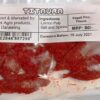 |
₹300.00
|
|
5 in stock |
||
|
|
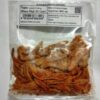 |
₹360.00
|
|
1 in stock |
||
|
|
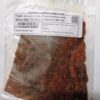 |
₹360.00
|
|
4 in stock |
||
|
|
 |
₹300.00
|
|
1 in stock |
||
|
|
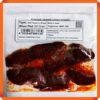 |
₹300.00
|
|
2 in stock |
||
|
|
 |
₹300.00
|
|
2 in stock |
||
|
|
 |
₹180.00
|
|
2 in stock |
||
|
|
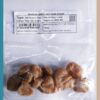 |
₹300.00
|
|
2 in stock |
Titora – Titaura! Get 58 Best Titora Online – Lelow Online.
Titora – Titauras – Titawra – Paun, are one of the vital frequent meal delicacies in Darjeeling (famous for its tea) and Sikkim, often constructed from fruits. As you move by means of the streets, you can find chains of outlets promoting these candy, bitter, and spicy Titauras.
Piro Titora, Best Amilo Titaura! Get 44 Best Titora Online – Lelow Online. Sikkim is legendary for titular and individuals who come to go to Gangtok from different components of India be sure to take titaura again with them as a memento in addition to presents to their associates and expensive ones.
Titora
Anyone who is from Darjeeling already knows what Titora is. Just thinking about it, my mouth is salivating already. For the rest of you who don’t know, Titota is sweet, sour, salty, or hot or a mixture of all those made from fruits like lapsi (pronounced “Lopsy”) which is also known as Hog Plum or the scientific name Choerospondias axillaries. Titora is also known as Paun in the native language of Darjeeling.
Titora seems to be famous among teenage girls so it is also known as lyase Paun. In the local language, the word lyase means young girl.
Lapsi is found in Darjeeling in the hills and they bloom in spring which is around March/April. Lapsi grows in a tree and it has a green cover with flesh and a single seed stone inside when it is ripe. Lapsi by itself tastes sour but when they make Titaura, they boil lapsi and take the sandstone out.
Lapsi Dallo Masala Titaura:
Sweet and Mild Spicy in Taste
Ingredients: Lapsi, Sugar, Salt, Spices, and Chillies.
EAN: 4202844888202
| S. No | Flavour | Type | Price |
| 1 | Aamla Titora | Spicy | 48 |
| 2 | Aap Jhol | Khatta | 58 |
| 3 | Amilo Piro Tukra | Khatta & Spicy | 48 |
| 4 | Bechi Patta | Salty & Sour | 48 |
| 5 | Bechi Paun | Salty & Sour | 58 |
| 6 | Charpatte Masla Titora | Spicy & Khatta | 48 |
| 7 | Chatpat Masala | Spicy | 48 |
| 8 | Chini Candy | Sweet & Sour | 58 |
| 9 | Chini Patta | Sweet & Sour | 48 |
| 10 | Dallo Piro | Spicy | 48 |
| 11 | Dry Lapsi Titora | Khatta | 48 |
| 12 | Golo Piro | Spicy | 48 |
| 15 | Guliyo Piro Patta | Sweet & Spicy | 48 |
| 16 | Imli Guilyo | Sweet & Sour | 58 |
| 17 | Imli Jhol | Khatta & Spicy | 48 |
| 18 | Imli piro | Spicy | 48 |
| 19 | Kagati Bechi | Salty & Sour | 58 |
| 20 | Kagati Chatpat | Spicy & Sour | 58 |
| 21 | Kagati Jhol | Khatta & Spicy | 48 |
| 22 | Kagati Titora | Spicy | 48 |
| 23 | Khattu | Sour- Khatta | 58 |
| 24 | Lamo Candy | Khata Mittha | 58 |
| 25 | Lamo Chatpat Paun | Khata Mittha | 58 |
| 26 | Lapsi Candy Piro | Spicy | 48 |
| 27 | Lapsi Candy Titaura | Sweet & Sour | 48 |
| 28 | Lapsi Dallo Candy | Sweet & Sour | 58 |
| 29 | Lapsi Dallo Masala | Spicy | 58 |
| 30 | Lapsi Dallo Piro | Spicy | 58 |
| 31 | Lapsi Piro | Spicy | 48 |
| 32 | Lapsi Spicy Balls | Spicy | 48 |
| 33 | Lapsy Candy Spicy Sugar | Spicy | 58 |
| 34 | Masala Imli Piro | Spicy | 58 |
| 35 | Nunilo Kagati | Salty & Sour | 48 |
| 36 | Orange candy | Sweet & Sour | 48 |
| 37 | Piro patta | Spicy | 48 |
| 38 | Pura Charpate Masala | Spicy & Sour | 58 |
| 39 | Semi Lapsi Dallo Candy | Sweet & Sour | 58 |
| 40 | Special Lapsy Candy | Sweet & Sour | 58 |
| 41 | Sweet Candy Pulp | Khatta Mittha | 48 |
| 42 | Sweet Delight | Sweet | 48 |
| 43 | Tukra Chatpat | Spicy | 48 |
| 44 | Tukra Piro | Spicy | 58 |
| 45 | churpi | Cheese | 450 |
- Semi Lapsi Dallo Titawra
- Semi Lapsi Dallo Candy
- Sweet, Spicy, and Sour in taste.
- Ingredients: Lapsi Pulp, Sugar, Chilly, Salt, Black Salt, and Hing.
EAN: 4202848888024
Lapsi Dallo Candy Paun
Ingredients: Lapsi Pulp, Sugar, Chilly, Salt, Hing, Permitted food colours.
Lamo Chatpat Paun
The flesh is made into the sticky gravy and is blended with salt, sugar, chili, and different spices so as to give them the variant tastes like candy, bitter and sizzling Titauras. Lapsi candies are additionally one of the vital widespread and favourite munch-on for the youngsters in addition to the elders and the lapsiko titaura is an all-time favourite for a lot of.
Lapsy Candy Spicy Sugar Titaura
The gluey flesh is mixed with ingredients like sugar, chili, salt, other spices depending upon what type of Titaura needs to be made. Then it is dried in the sun before packing in a plastic pouch to sell it.
Wash the natural fruits
Boil in Saltwater
Drain Water
Mash Boiled Fruit
Remove the seeds
Grind the pulp to homogenize
Dry for a week in a bright sunny day
Cut it into small pieces
Titauras sheets are ready
Now add flavors to the suitability
There are many shops in Darjeeling for Tea and Titora. The Titora from Lelow Online is sold everywhere in India from the corner shops to supermarkets. These days you also find Titora made from mango, tamarind, dates, lemon, gooseberry, and lime.
For the last few years, we have been lucky to get Titora in entire India and abroad as well. It does not cost much and is worth the price for the treat sometimes. I love the sweet ones a lot. Not a big fan of salty and hot ones.
If you ever get a chance, do try it out. You may like it.
Lapsiko Titaura
These tangy, candy, and bitter with sour taste is available in totally different varieties and are made of various fruits, nevertheless, the commonest of all of them is the lapsiko titaura, produced from the Lapsi fruit, scientifically generally known as Choerospondias axillaries.
This fruit turns greenish-yellow when it’s ripe and has a single seed inside giving bitter style to the tongue. The method of creating lapsiko achar and lapsiko titaura is kind of related.
Titaura
For making titaura, initially, the fruit is collected in large bowls and is about to boil. The seed, after boiling, is separated from the flesh after which, the flesh is mixed and poured into large picket molds and left within the solar to sun-dry them.
Not solely within the outlets close to M.G. Street but additionally, many different locations in Sikkim sell tiaras, largely going by the title of Paras Agro Meals, Darjeeling. Additionally, generally known as pau, these titauras are fairly well-known souvenirs to be taken again house from Sikkim.
Flavors Available in Titaura
Amilo Titora
For making piro titaura, to begin with, the fruit is collected in large bowls and is about to boil. The seed, after boiling, is separated from the flesh after which, the flesh is mixed and poured into large picket moulds and left within the solar to sun-dry.
The plum is made into sticky gravy and is combined with salt, sugar, chilli and different spices to be able to give them the variant tastes like candy, bitter and sizzling Piro titaura.
Lapsi candies or Piro titora are additionally one of the vital well-liked and favourite munch-on for the children in addition to the elders and the lapsiko titaura is an all-time favourite for many.
Spicy Piro Titaura
The bitter fruit is made into numerous dried merchandise, together with candy sweet and spicy, crushed fruit strips. The candy lapsi sweet is available in numerous varieties, together with small rectangular strips or square cubes, that is mild yellow in shade and has a candy, nearly floral taste.
For those with no candy tooth, dried and spiced lapsi is one other native favorite. The pure sourness of the lapsi fruit, combined with the flavour of chilli and spices, creates a particular and multilayered style that’s distinctive to dried fruits in Himalaya. Titora Nepal food.
However to get a real style of the characteristically Nepali flavor of the snack, select one of many spiced varieties just like the Tukra Piro, Lamo chatpat, or bechi titaura. Piro Titora or Piro Titaura, which is offered in particular person plastic packs or in bulk, is a pulp-like substance comprised of crushed and processed native fruits.
The titaura pulp is usually dried, spiced after which minimize into strips, however, can be offered in moist in addition to pulp varieties. Titaura is flavoured with a mess of spices, together with masala (spice) blends and chilli powder.
Lapsi Titaura is comprised of lapsi (Hog Plum/Choerospondias axillaries), which is a native fruit from Himalaya. It’s combined with salt, sugar, chilly, and spices. It’s bitter, candy, and spicy in style. The plum lapsi, comprises an excessive degree of vitamin C.
Titaura is very well-liked meals in the Nepali population as a snack often made with fruits. It’s a favorite amongst teenagers and adults. Titaura is often known as Paun in Nepali . . Paun actually means bitter and sour in Nepali. A few of the varieties are candy and salty whereas some are extraordinarily spicy.
Nowadays you additionally find Titaura comprised of mango, tamarind, dates, lemon, gooseberry, and lime.
Is Piro Titaura Chilly?
Yes, but there are some flavours like Amilo Piro they are sweet and chilly. Additionally, these Titauras are fairly well-known souvenirs to be taken back home.
Enjoy Spicy dalmaut mixture Spicy Dilanranjan Dalmaut. Khattu Titaura Special Bayar Candy Preserved Fruits-Dry Fruits Khattu titaura. Related to Titaura Legacy, a delicacy to enjoy.
Ingredients of Khattu:
Sugar, Salt, Liquorice, Citric acid and Pressed plum Bayer.
Ingredients Needed
Lapsi Candy – 1 packet
2 cups water
Sugar – 1 tbsp
Pinch of hing or asafetida powder
Chili powder (optional) for extra spicy
Salt and turmeric powder to taste
Jal Jeera Powder – 1/2 tsp
Black Salt Powder – 1 tsp
Mustard Oil – 1 tsp
Fenugreek Seeds – 1/2 tsp
Steps to follow
Boil 2 cups of water in a saucepan. Add 1 packet of Lapsi (Nepali Hog Plum) candy and let it cook for a few minutes until lapsi starts to melt. Stir it with a spatula at times. Turn off the heat. Cool for about 5 minutes.
While it’s getting cooled off, add a tablespoon of sugar, a pinch of Hing or Asafoetida powder, chili powder if the candy isn’t that spicy enough for your taste, salt to taste, 1/2 tsp of Jal Jeera Powder, and 1 tsp of Black Salt Powder into the mixture. Mix well in a blender.
Add Turmeric Powder on top of the mixture. Meanwhile, heat 1 tsp of mustard oil on medium heat and add 1/2 tsp of fenugreek seeds. When it turns dark, turn off the heat and pour it into the mixture.
Paun is ready! Enjoy!
Mayla Daju was ten years old when he first tasted lapsi in his hometown of Darjeeling. The raw fruit was very sour and at first, he didn’t like it, but over time the taste grew on him. Now in his 80s, Daju tends lapsi trees on his two ropanis of land in Mirik. Though the family is engaged in other farming as well, every February Chettru’s son Gopal travels to Darjeeling with four sacks of lapsis from their farm.
The Chettris’ lapsis are bought up in no time, and the family is happy with its sales. The demand for lapsi in Darjeeling is so great, supply cannot keep up.
“When I was first introduced to lapsi, I picked it from a tree,” says Chettri, “I didn’t know the fruit would be so much in demand in the city. I was so surprised to learn that we could add all sorts of spices, from sour to sweet, and consume it with our daily meal as a pickle, or that it could even be candy.” Indeed, during the September-January lapsi harvesting season, households all over Darjeeling make multiple varieties of homemade pickles and sweet-and-sour candies from this favourite fruit.
Lapsi (Choerospondias axillaris) is a tree native to much of Asia, including China, India, Nepal, Vietnam, and Thailand and as far east as Japan. According to botanist Nar Bahadur Gurung, it comes from the Anacardiaceae family – the same genus as mangoes – whose fruits have moist, thick pulp on the outside and a hard kernel on the inside. In English, lapsis are often called Nepali hog plums, but Gurung avoids this term so as not to confuse it with the real hog plum (Spondias mombin) similar to the lapsi but is native to the tropical Americas.
Lapsi are cultivated particularly in hilly regions and the trees grow up to 30m high. Unlike other members of the Anacardiaceae family, Choerospondias axillaris trees can be male or female, and farmers may not be able to differentiate between them until they have reached maturity. Female trees give more fruit.
Gurung of Machhindra Bahal in Kathmandu always woke up to a house smelling strongly of lapsi. Gurung maternal family, and especially his aunt, made titaura from lapsi peels and pulp.
Opened almost 50 years ago, Titora manufacturing was once hugely popular. The business did so well that in 1997 it shifted production out of the family kitchen and into a factory in Mirik, which now churns out more than 30 varieties of titaura. In 2017, the shop itself moved from Park to New Road in Darjeeling
According to Gurung, lapsi is very popular and the supply falls well short of demand. The Paun Store needs 2,000 to 3,000 kg of lapsi a day to make four types of treats – dry titaura, Jhol titaura, and candies. A current favourite among customers is the recently introduced lapsi titaura.

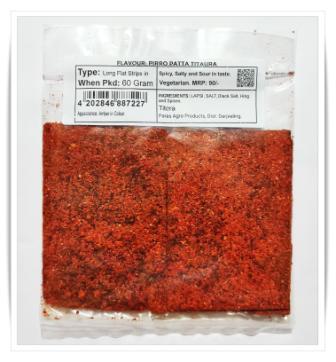
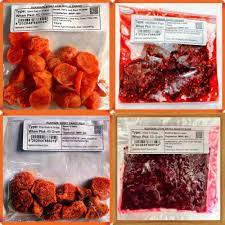
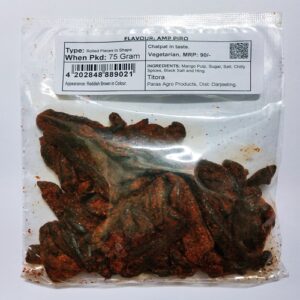



Reviews
There are no reviews yet.